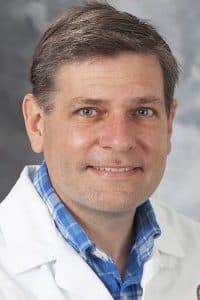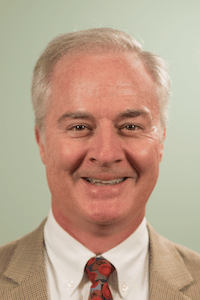One year later, the COVID-19 pandemic continues. However, the development of novel treatments and vaccines made available through the tireless efforts of scientists in the past year have set the wheels in motion for a post-pandemic future.
Morgridge virologist Johan den Boon, UW Health anesthesiologist Dr. William Hartman, and UW–Madison School of Medicine and Public Health pediatric infectious disease specialist Dr. James Conway, joined Gabriella Gerhardt on February 24 for a webinar in the Fearless Science Speaker Series about the science of vaccines. The following highlights are some of the key takeaways. A recording of the webinar can be viewed in full above.
Biology basics
“What do these viruses do? It’s pretty simple. They like to get into your cells. They like to persuade you to multiply them. And then get out and infect the new cell, either in your body or somebody else’s body,” den Boon says.

Den Boon uses the analogy of a chain letter being delivered to your door, with the intent of being copied repeatedly so it can be sent to others.
“In fact, we call the outside of these viruses the viral envelope,” he says. “And the spike proteins that are sitting on the outside are kind of like and address label that targets this virus to the right kind of cell.”
This is some of the work that den Boon and his colleagues conduct in the John W. and Jeanne M. Rowe Center for Research in Virology — understanding the basic mechanisms of how viruses replicate and interact with their host.
“We need to train ourselves to recognize these enemies before they actually arrive,” says den Boon.
The new mRNA vaccines developed by Pfizer and Moderna offer an elegant strategy to prime the immune system against SARS-CoV-2 infection.
“It’s just simply providing an RNA that encodes the spike protein,” den Boon says. “The good thing is that kind of a molecule is easily adaptable to any kind of changes the virus throws at us.”
As the virus continues to replicate and spread to new hosts, mutations are inevitable. But den Boon says that the best way to stop the rise of more variants is to make sure people don’t get infected in the first place — so it’s important to continue with vaccination efforts until herd immunity is achieved.
“We also need to be vigilant about surveying the coronavirus evolution to anticipate any of these variants coming up in the future.”
Trials and therapeutics
UW Health and the UW School of Medicine and Public Health used a calculated and educated approach to investigate therapies and clinical trials to benefit patients in Madison, throughout Wisconsin, and the global population.

“Last March when COVID came to the United States, we didn’t have any effective therapeutic options,” says Hartman. “So, our first goal was to put out the fire.”
There are many strategies to neutralize a virus, but one of the quickest ways to get antibodies is by taking them from someone who has been infected and already recovered. One way to do this is through the transfer of convalescent plasma.
“By being able to use convalescent plasma early, we were able to keep people sick with COVID out of the ICU, off of ventilators and reduce overall mortality,” Hartman says.
Convalescent plasma became one of the first treatments approved by the FDA through an emergency use authorization (EUA). Hartman notes it was available to everyone, which is a big issue for health equity.
The next evolution of treatment came from identifying the strongest neutralizing antibodies — monoclonal antibodies that targeted the spike protein.
UW partnered with Regeneron to investigate inpatient, outpatient, and preventative impacts through a trial of their monoclonal antibody cocktail.
“We were able to reduce medical visits in people who were at risk of developing severe disease,” Hartman says. “They were able to clear the disease very quickly, usually within five to seven days, feel a lot better and actually become less infectious overall.”
The FDA also approved Regeneron by EUA for outpatient use.
Finally, UW participated in the AstraZeneca trial — an adenovirus vaccine which primes the immune system to produce antibodies that will attack the spike protein.
“This has been one of the most difficult trials to run, as we’ve had to do everything that a classical vaccine trial would do, but in a much shorter time frame,” says Hartman. “we’ll know by the end of this month how efficacious this particular vaccine is, and will continue follow up on these participants for the next two years so we know how long that immunity lasts.”
Rapid response
“I think it’s important to recognize how quickly all of this has evolved,” says Conway. “And as we realized how quickly we needed to respond to this, we needed to understand exactly what we understood about coronaviruses in general.”

Coronaviruses circulate routinely, causing common colds to more severe versions like the SARS-CoV-1 and MERS outbreaks.
With the current COVID-19 pandemic, the need for a vaccine became apparent quickly.
In regard to developing a vaccine, Conway says it comes down to basically two different questions: are they safe, and do they work?
“We would like that immunity to be long lasting,” he says. “We would like this to prevent infection, but also to prevent transmission to others.”
Researchers have noted many challenges to developing a vaccine against SARS-CoV-2, from trying to predict long-term mucosal immunity to protection against new mutant variants that occur. What is the best method of deliver? Will we need boosters?
“I think we actually have reasons for some optimism,” Conway says. “This has been an unprecedented global effort to develop vaccines — both collaboration amongst scientists to understand these viruses and immunity, as well as collaboration between companies and the widespread sharing of information.”
Historically, vaccine development is a long process, requiring preclinical phases into three trial phases before it’s eventually licensed.
Operation Warp Speed helped expedite that process by eliminating any financial disincentive for manufacturing and shipping that would lead to delays.
“The FDA was available and willing to rapidly review these processes in real time,” says Conway.
The efforts of Operation Warp Speed have resulted in two EUA approved mRNA vaccines (Moderna and Pfizer), with vaccines from Johnson & Johnson and AstraZeneca under review or close to review. Several other candidates are in the works as well.
“I think for the time being, while only a limited population of the United States are immunized, we’re going to continue to ask people to perform their mitigation activities,” Conway says. “But as we get closer to herd immunity and see what this outbreak looks like, we will hopefully be able to get gradually back to more and more normal behaviors.”